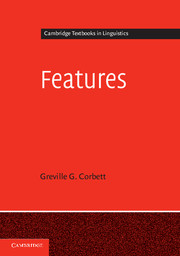Book contents
- Frontmatter
- Contents
- Figures
- Tables
- Preface
- Abbreviations
- 1 Why features?
- 2 Formal perspectives
- 3 Features for different components
- 4 Justifying particular features and their values
- 5 Typology
- 6 Canonical Typology and features
- 7 Determining feature values
- 8 Feature-value mismatches
- 9 Conclusions
- Appendix Standards and implementations
- References
- Author index
- Language index
- Subject index
7 - Determining feature values
A case study on CASE
Published online by Cambridge University Press: 05 November 2012
- Frontmatter
- Contents
- Figures
- Tables
- Preface
- Abbreviations
- 1 Why features?
- 2 Formal perspectives
- 3 Features for different components
- 4 Justifying particular features and their values
- 5 Typology
- 6 Canonical Typology and features
- 7 Determining feature values
- 8 Feature-value mismatches
- 9 Conclusions
- Appendix Standards and implementations
- References
- Author index
- Language index
- Subject index
Summary
Imagine that it mattered to us how many teeth a giraffe has, or how many stomachs a llama has. Perhaps unaware of the potential difficulties, we might expect zoologists to be able to give us answers to such queries. Linguists have been asked comparable questions increasingly frequently in recent years, as various researchers attempt large-scale comparisons, based on seemingly straightforward measures like the size of the phoneme inventory, the number of morphosyntactic feature values, and so on. Yet the question ‘how many case values has Russian?’ was mentioned earlier (§4.1.2, footnote 4), as a difficult question that has given rise to a considerable literature. Why then is the task difficult? We expect the zoologists to have rounded up a few healthy giraffes, persuaded them to open their mouths (!), and to have counted and recounted the number of teeth. The linguistic question requires instead the specification of a system. Rounding up a few Russian nouns will not do. We want an account of all the possibilities, which means checking other parts of speech too and different contexts. But having established the largest number of possibilities we also want a realistic picture of how the case values are distributed across the lexicon. While we might be forgiven for not knowing the issues of classification and definition which zoologists face, we should be aware of the dangers of simple answers to apparently simple questions within our own discipline.
We have seen already (§§4.1.2–4.1.3) that establishing feature values can be challenging. We now look at a single language and find that the difficulties we identified scattered across different languages can co-occur in one. We analyse case in Russian, partly because we have so far given less attention to case, partly because there is a tradition of debating the case values of Russian, which was significant in the development of the Set-theoretical School. But mainly, we look at case in Russian to demonstrate that features are not ‘clean and neat’, nor even clean and neat apart from occasional exceptions. They are more interesting than that. Russian certainly presents a worthy challenge, with different analyses giving it as few as six case values or possibly as many as eleven. Given the preparation in §4.1.2 we can now take on this challenge. Furthermore, the canonical approach, which uses a logical scheme against which to evaluate the different values proposed (§6.2), will prove equally useful. We go into some detail, partly to prove the points claimed, but also to show the complexity of a feature system when analysed thoroughly.
- Type
- Chapter
- Information
- Features , pp. 200 - 222Publisher: Cambridge University PressPrint publication year: 2012



